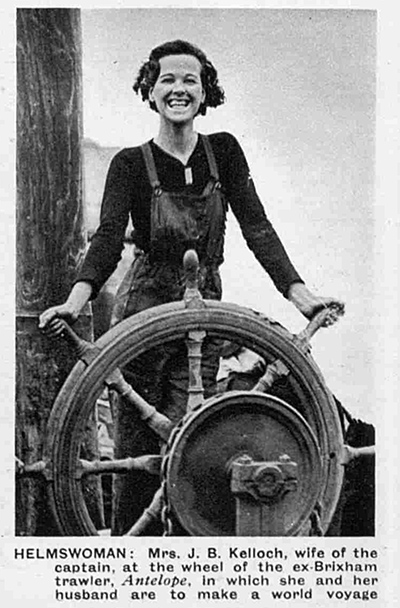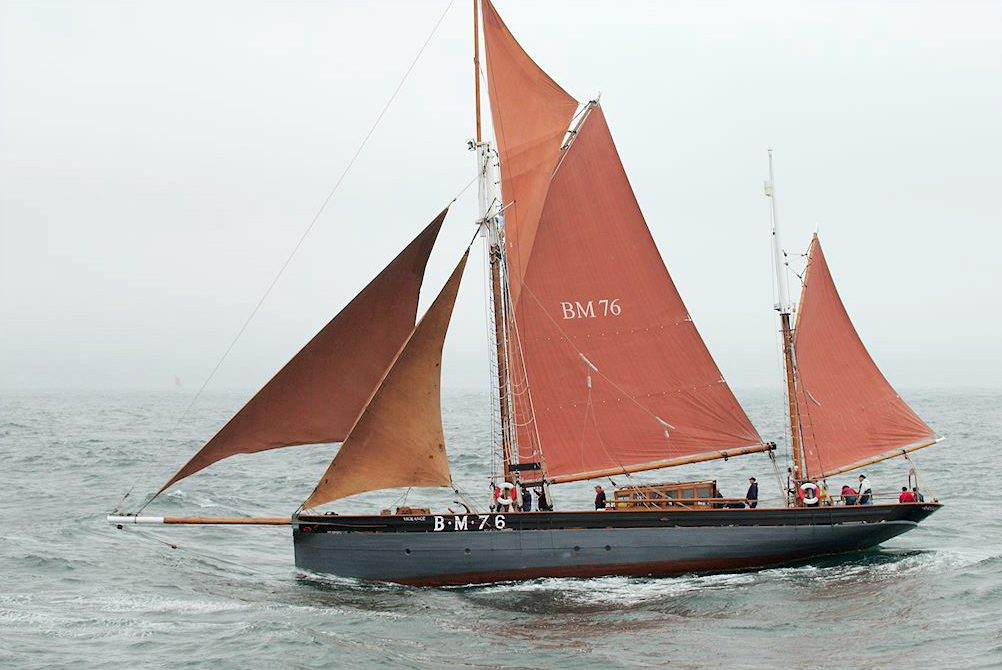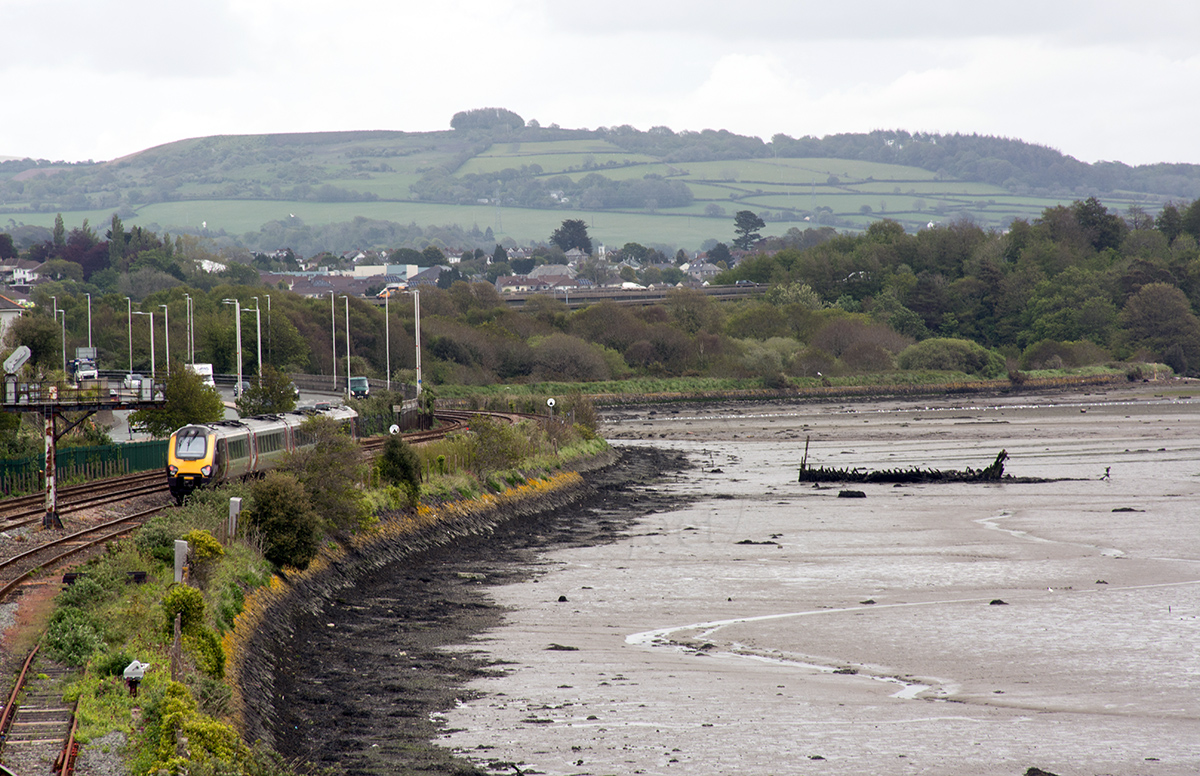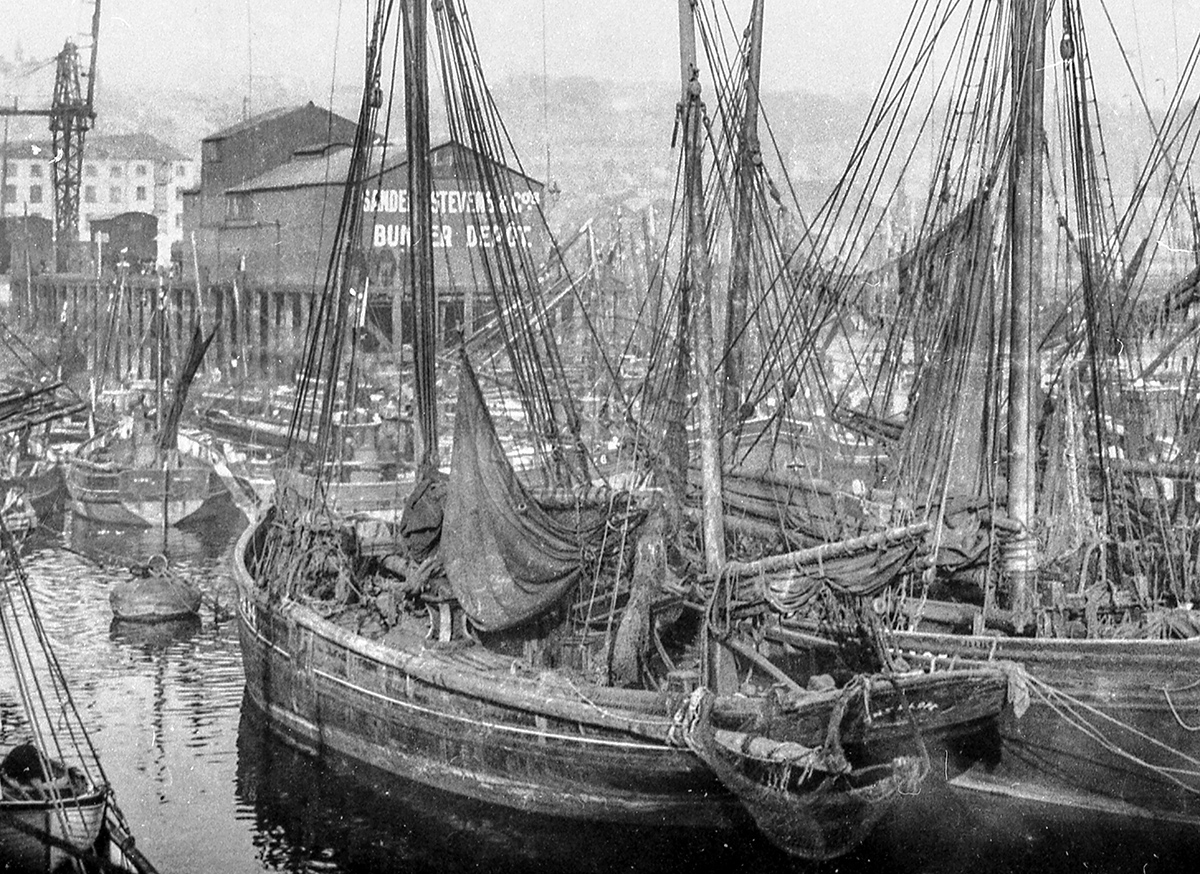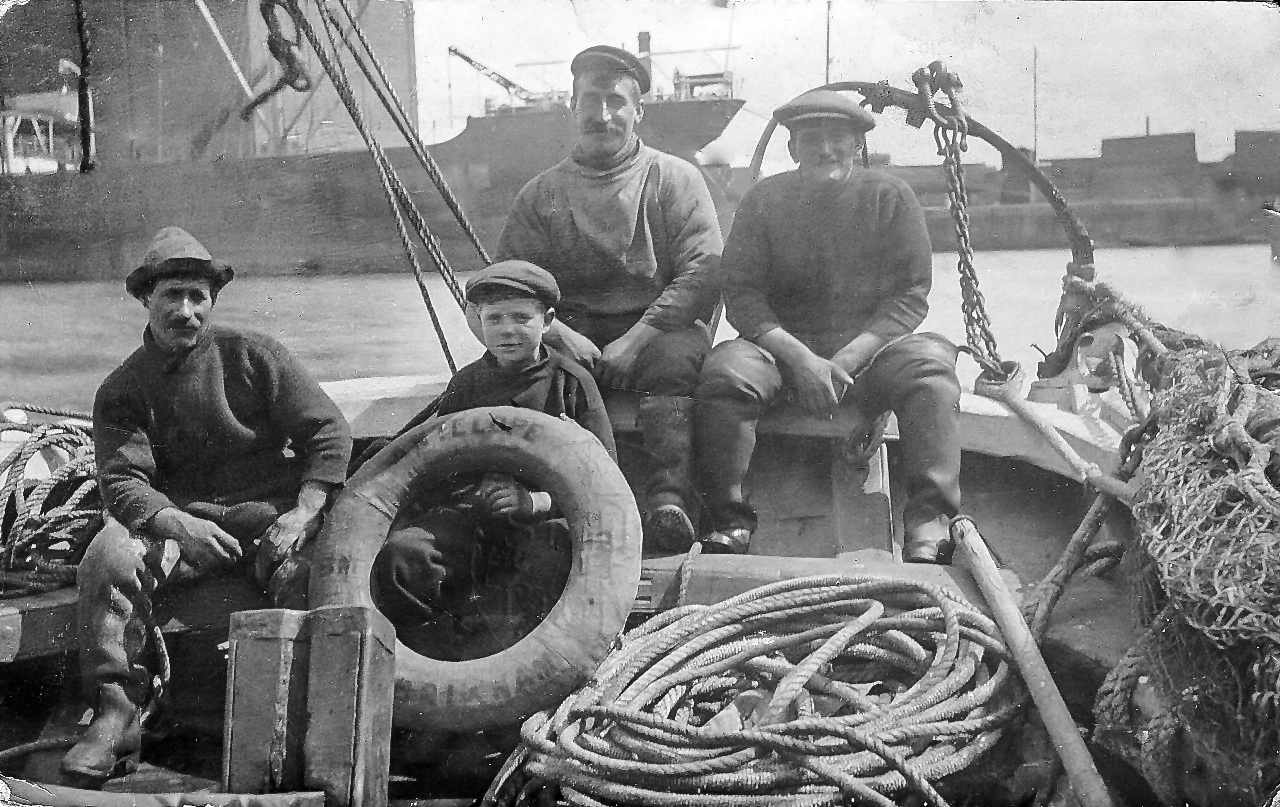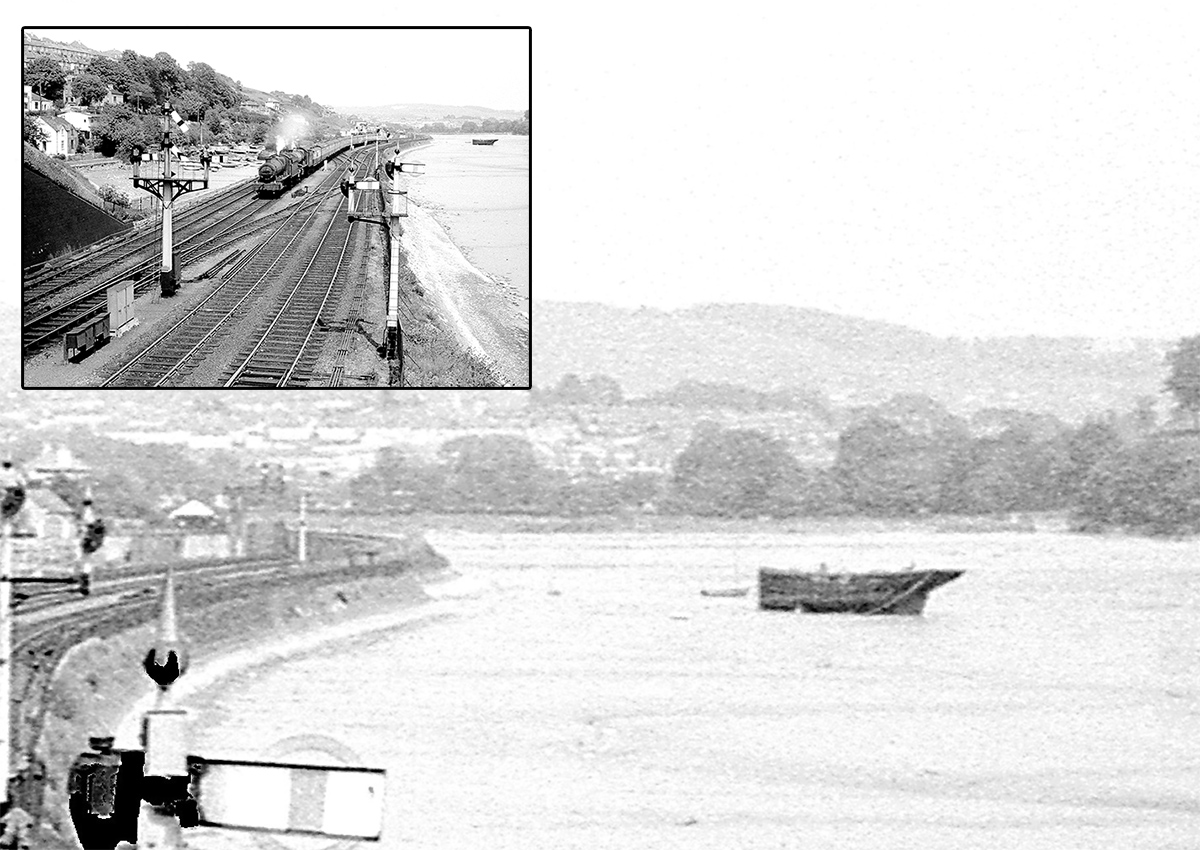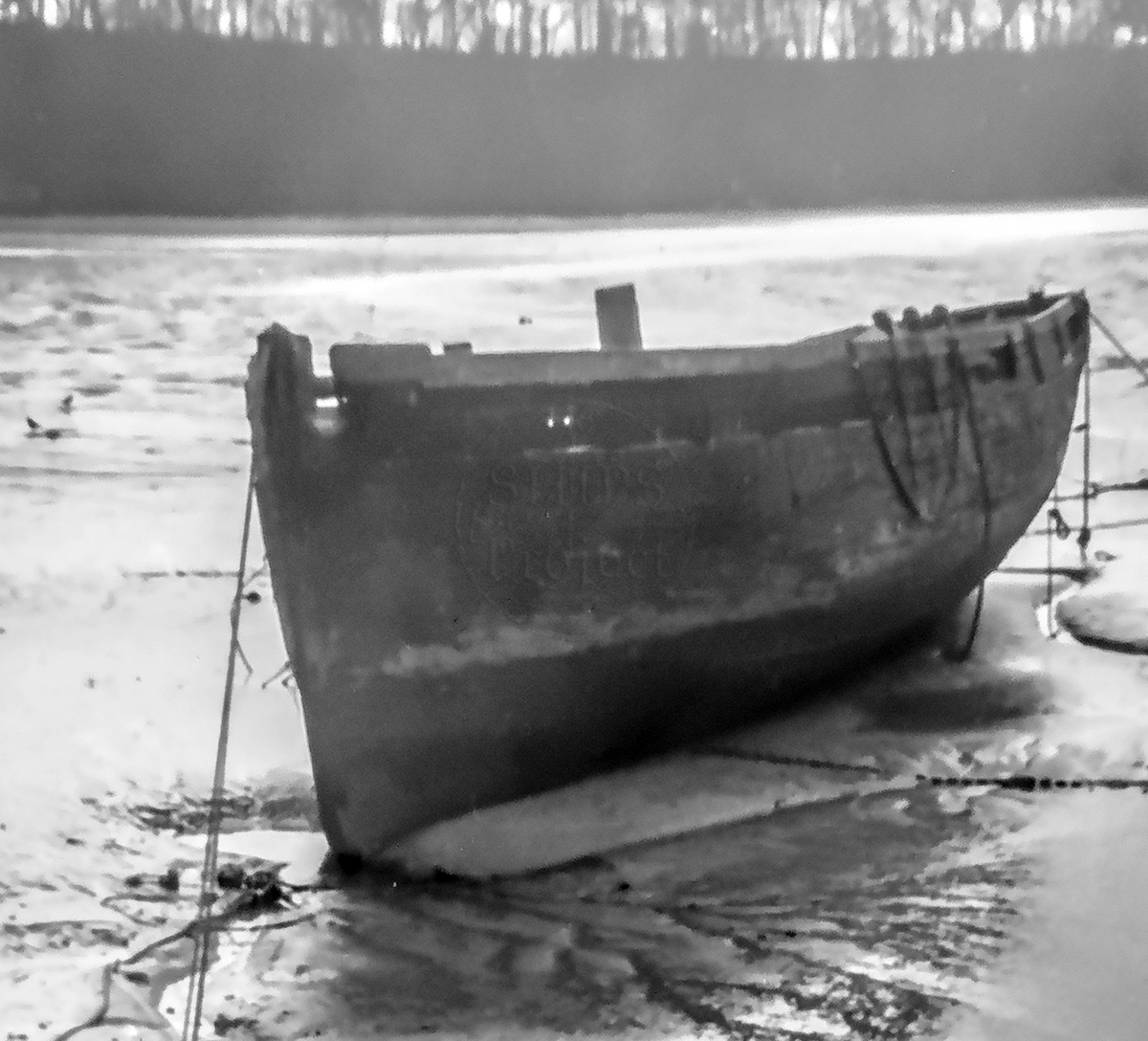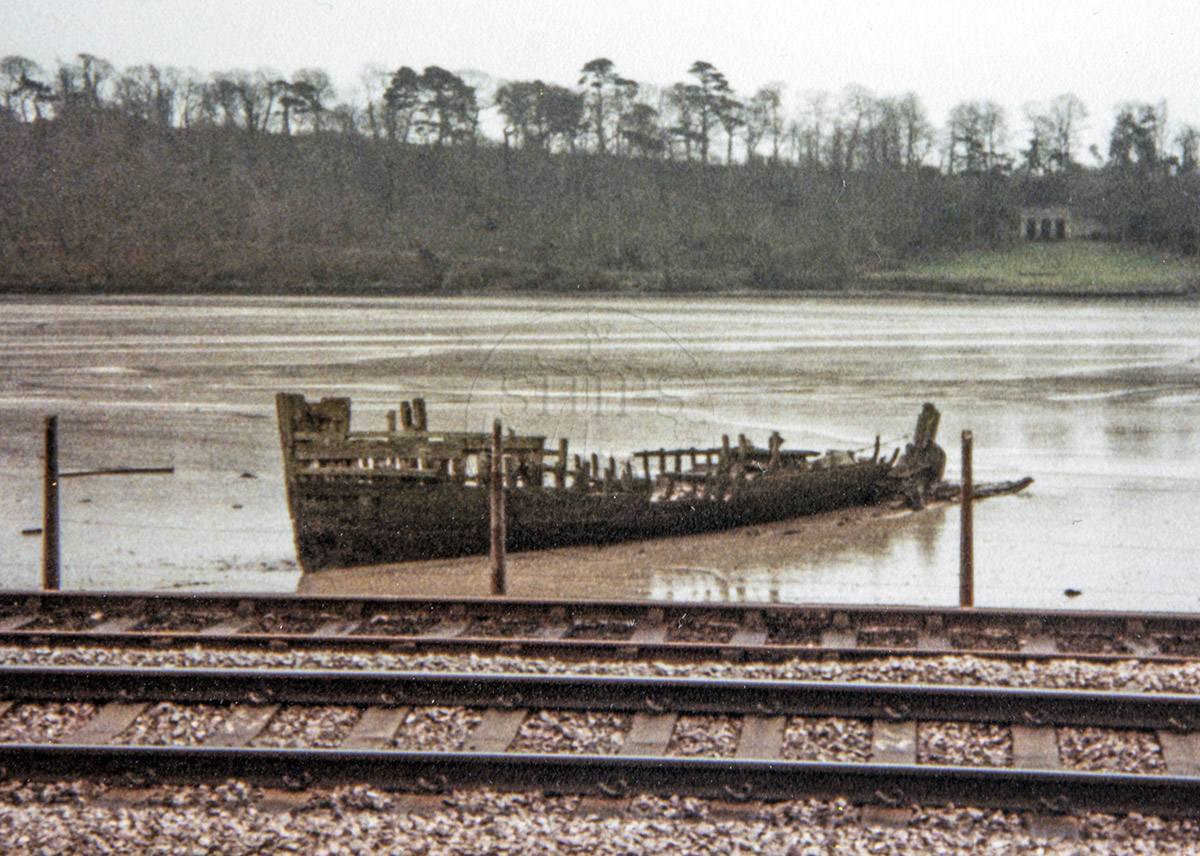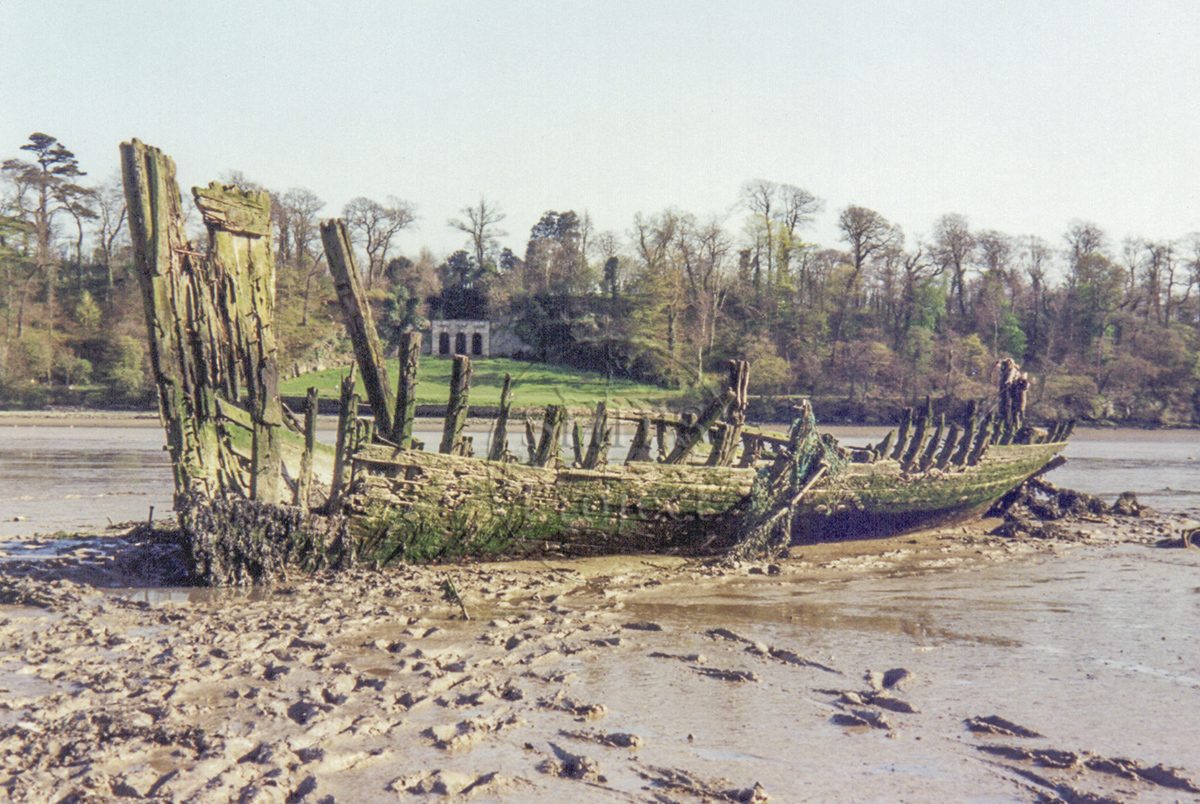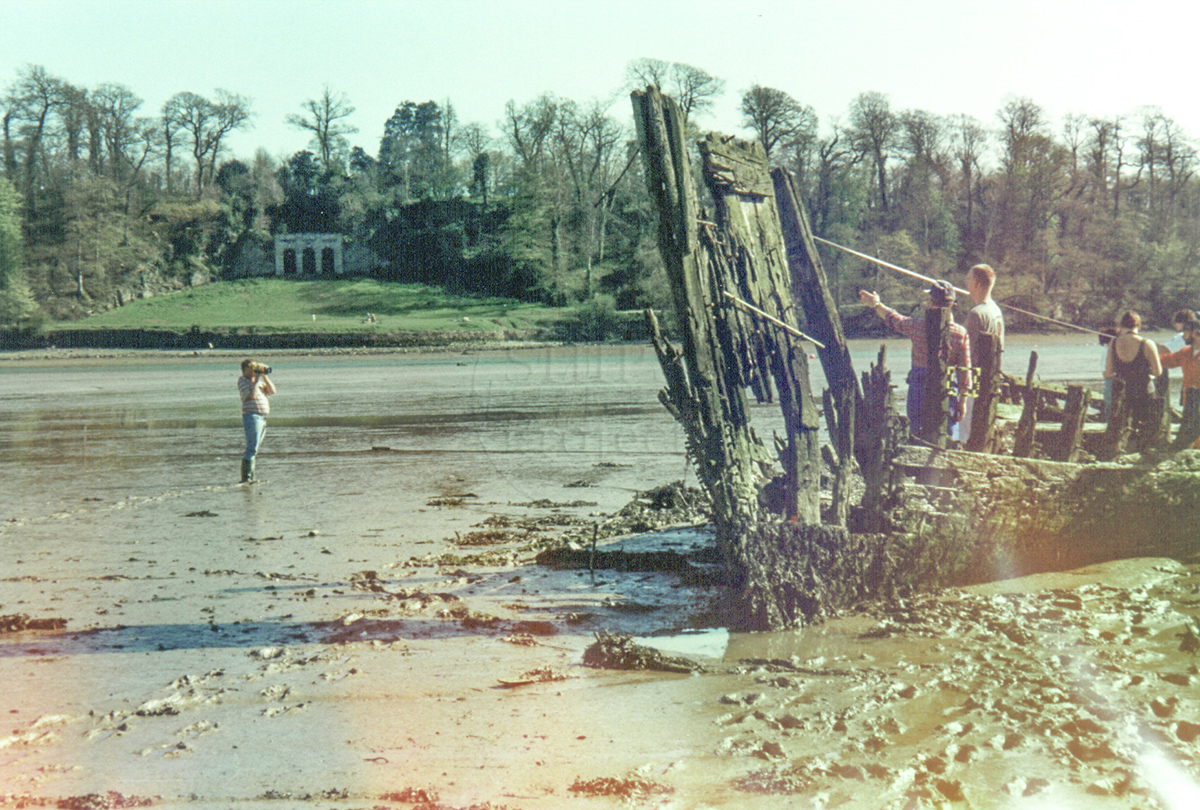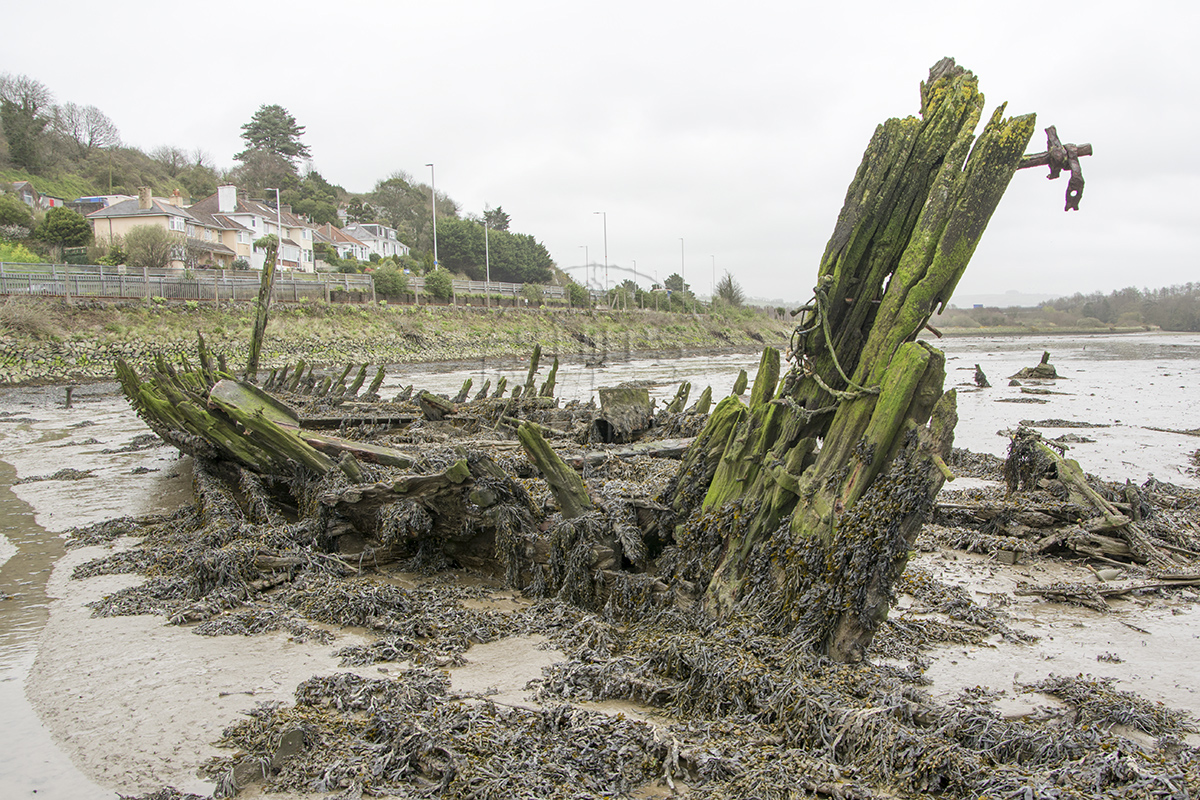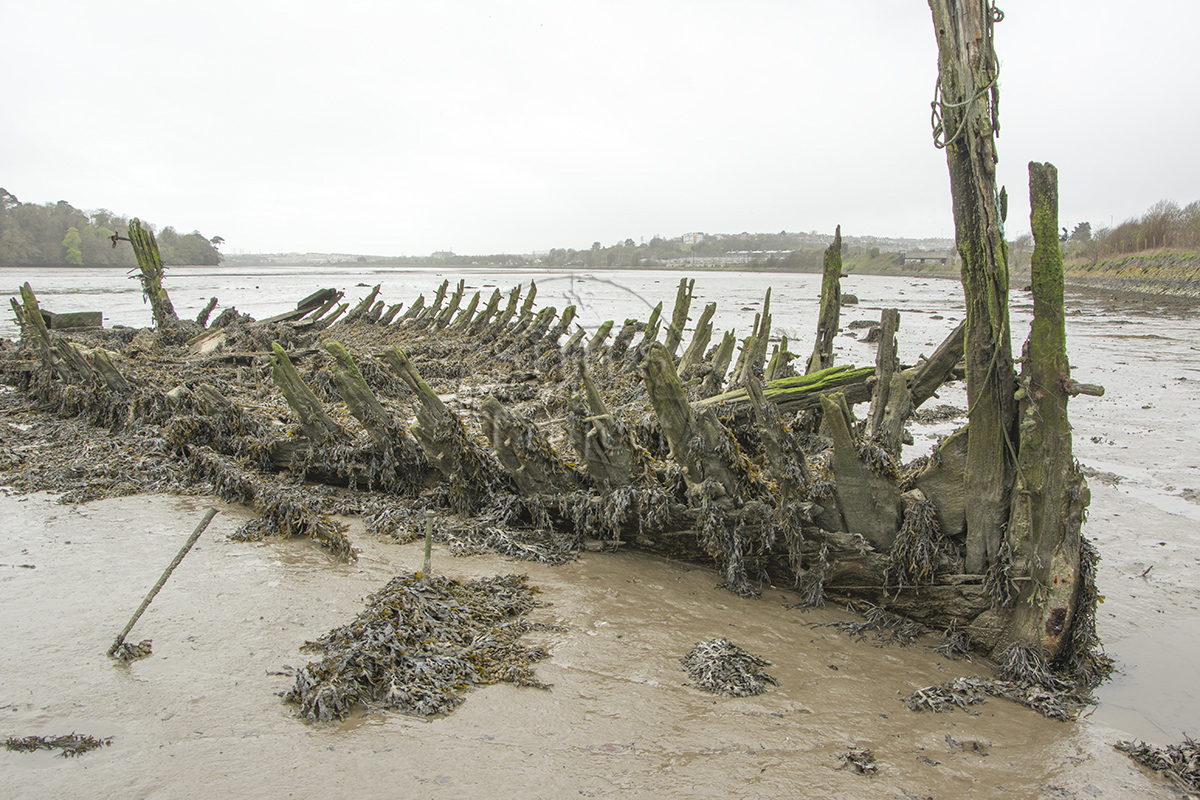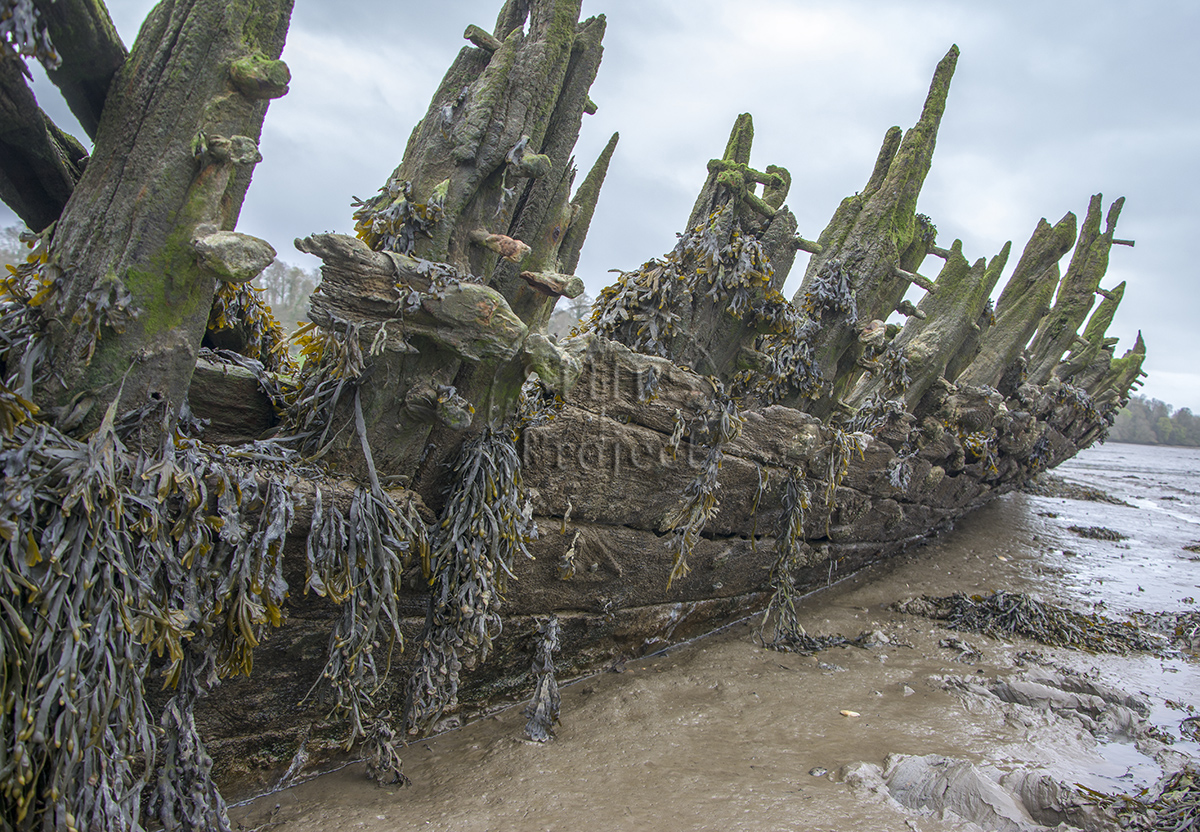Not Set
Hulk of a fishing boat abandoned on the Embankment, Laira, Plymouth.
Type
Brixham Trawler
History
The remains of the Brixham trawler Antelope can been seen alongside the main road in and out of Plymouth, close into the western side of the Laira. Having been abandoned there in the 1950s the Antelope has slowly fallen apart over the years so now only the stem, stern post and lower frames remain.
The Antelope is a sloop class Brixham trawler built at the famous shipyard of R. Jackman Ltd. in Brixham in 1906. First owned by Mr. Richard Elliott of Brixham, she was registered in Brixham and given the port mark BM 128. The crew of four in 1915 were all Brixham men; the skipper was 48 year old Charles Gregory, Richard Soper was the 52 year old 2nd Hand, Harry Gregory the 3rd Hand at 19 years and Harry Cowling was the 16 year old Cook. During the First World War, Antelope became a fishery protection vessel with an auxiliary engine fitted in Plymouth dockyard and a gun mounted on her foredeck. In addition to her usual crew the gun was manned by two naval ratings for the duration of the war.
In 1916 the Antelope was sold to Plymouth fisherman Charles Drake who then mortgaged her for £425 to John Walk, she was registered in Plymouth as PH94. At this time Bill Hill was the mate on board and Charles Drake's son also called Charles was the third hand.
In 1920 Frank Hutchings and Arthur Harvey, a fishmonger and a fishing boat owner from Suffolk, bought the vessel for fishing off the East Anglian coast registering her in Lowestoft with port number LT774.
By 1925 the Antelope was back in Plymouth having again been bought by Charles Drake, operating as PH94. Later that year Drake mortgaged her to the Plymouth Fish Selling Co., for £250. On 2nd June 1928 the Plymouth Fish Selling Co. put up for sale by John R. Randall at the Barbican 'the well-known and up-to-date sailing trawler Antelope' along with a number of warps, spare trawl heads, a boiler, 20 tons of iron ballast, 2 mainsails, 3 jibs, 1 mizzen topsail, 3 anchors, 60 fathoms of chain and a 30 fathom trawl warp. The Antelope was sold to John 'Jonny' Taylor who mortgaged her back to the Plymouth Fish Selling Co. In 1934 she was in the hands of Plymouth iron merchant Thomas Turner but by this time steam had replaced sail and the fishing days were nearly over for a boat once known as the fastest trawler in Plymouth.
In 1935 she was again up for sale but this time simply described as 'cheap, Auxiliary trawler Antelope, new spars, rigging' lying at Oreston. Turner sold the Antelope to John Kellock who converted her from a fishing trawler to a yacht, with the intention of undertaking an expedition of over 25000 miles to the southern seas. The adventure was described by the press as ‘Four disgruntled men and two women on a secret quest’. The adventurers were Mr J.B. Kellock a garage proprietor, Mr D. Taylour an engineer, Mr J. Mackern also an engineer, Mr P.J. Christian a bank clerk, Mrs Kellock and Miss Eva Kellock, bonded by ‘The idea that obsesses us all is the rottenness of civilised life’. The expedition had been Mr Kellock's dream for 10 years, they planned to make a film of their travels but were not letting on what the scheme involved, Kellock told the press that ‘our other plans are my own secret entirely, the rest of the party will not be told until we have left port’, ‘No it is not a treasure hunt, but I can say it is something which has been tried only rarely before’. The plan was for the trawler to cross the Atlantic and enter the Pacific but her later course would depend on the success of the mystery quest.
Kellock paid Mashfords boatyard at Cremyll to refit the trawler, they sheathed her hull with zinc as a protection against marine borers and make her appearance smart again. Antelope was fitted with a new deck, reported to be from 'the timbers of an old wooden wall, the Defence', but its more likely to have been from the Ironclad of that name scrapped at Devonport in 1935.
By September 1936, unfavourable weather delayed the vessel that was lying in the Hamoaze near Mashfords boatyard, waiting to leave for Falmouth which was their point of departure for the adventure. But something must have gone wrong with the plan to escape civilisation because just one year later Kellock sold Antelope to Horizon Hunters Ltd. in Newton Abbot who fitted her with a new engine. The motor was built in 1926 by The Gas Plant of New York, U.S.A. It was a 4-cylinder motor; each cylinder was 5” with a stroke of 7”. 40 h.p. and a top speed of 4½ knots. In 1938 Horizon Hunters sold the vessel back to John Kellock who was by now a hotel owner. It is not known if the Antelope was used for war service during WWII.
In 1946 the Antelope changed hands many times; Kellock sold her to Donald Taylor who sold her to William Rushby and he sold her to David Harrison of Cremyll. In 1952, Harrison had the ‘Antelope converted to a houseboat and had her moored in Mashfords boatyard.
Sometime after this the Antelope was bought by Arthur or Harry Blagdon at a time when everything was in short supply after the war. Blagdon stripped Antelope of her fittings and the easily removable timbers then abandoned her on the mud alongside the railway line. This boat appeared in the film 'A Brief Journey - sailor's run ashore in 1954 to Plymouth, Dartmoor and Looe' ![]() which is the earliest record of Antelope abandoned on the mud. Ian Lane photographed Antelope at her new mud berth on 28 May 1956, she was in the background of his photo of the King Class locomotive 6002 King William IV piloted by a Hall class with the Great Western Railway dynamometer car (a vehicle testing the King's performance) on the down Cornish Riviera (Fig. 3). Antelope was initially afloat on a high tide but eventually bilged, sank and settled into the mud. The significance of this rare surviving example of the famous class of trawler was noted in a letter by Martin Langley to a newspaper in 1979 where the historian complained about someone stripping the hull for firewood and how the ship should be left alone. Antelope is recorded in the 1988 book Langley wrote with Edwina Small, 'Lost Ships of the West Country', which catalogues most of the hulks in the area (Fig. 4).
which is the earliest record of Antelope abandoned on the mud. Ian Lane photographed Antelope at her new mud berth on 28 May 1956, she was in the background of his photo of the King Class locomotive 6002 King William IV piloted by a Hall class with the Great Western Railway dynamometer car (a vehicle testing the King's performance) on the down Cornish Riviera (Fig. 3). Antelope was initially afloat on a high tide but eventually bilged, sank and settled into the mud. The significance of this rare surviving example of the famous class of trawler was noted in a letter by Martin Langley to a newspaper in 1979 where the historian complained about someone stripping the hull for firewood and how the ship should be left alone. Antelope is recorded in the 1988 book Langley wrote with Edwina Small, 'Lost Ships of the West Country', which catalogues most of the hulks in the area (Fig. 4).
Antelope is the last at least partial survivor of the once large fleet of Plymouth sailing trawlers. In 1996, the remains of the ship were investigated and recorded by a team from the Nautical Archaeology Society, south-west branch, led by Jon Parlour and Paul Dart (Fig. 5).
Read about this hulk on John Cotton's Historic Shipping website ![]()
Description
The Antelope is intact at keel level from stem to rudder, upright and lies with her bow to the north. When last investigated by The SHIPS Project in March 2017 the remains of the vessel include the keel, stem, sternpost, partial rudder, floor timbers, some ceiling and outer planking.
Identified by Ian Merry. This was one of the vessels recorded in the book Lost Ships of the Westcountry by Langley & Small.
This vessel is a Brixham trawler similar to the mule class Brixham trawler Wendew hulked in Hooe Lake and constructed by the same shipbuilder, Robert Jackman & Sons.
Location and Access
Embankment, Laira, Plymouth
The hulk can be seen from A374 Plymouth Road but the main railway line into Plymouth lies between the road and the ship so photography is difficult. Access can be achieved by walking alongside the river - park in layby on the Embankment Road, climb down the bank and walk up to the ship. The mud alongside the ship is up to 30cm deep in places so wearing waders or wetsuit boots is advised.
Nearby hulks include Laira 1 ![]() and fishing boat Ocean Maid
and fishing boat Ocean Maid ![]() and unknown boat Prince Rock 1
and unknown boat Prince Rock 1 ![]()
Last updated 22 May 2021
Information
Date Built:
1906
Builder:
R. Jackman Ltd., Brixham
Official Number:
122885
Length
67.3ft
Width
18.2ft
Depth in Hold
8.65ft
Construction
Timber, carvel, transom stern, ketch rigged
Propulsion
Sail, ketch rigged, auxiliary motor
Tonnage
49.97 GRT, 39 until 1916 then 23 net
Portmarks
BM128, PH94, LT774
Outcome
Abandoned before 1954, partly broken up
Reference
Unknown
C. John Cotton:
"After reading ‘The Westcotts & their Times’ by Ian D. Merry about the wreck of the ‘Bertie’, but not looking to read where it was. I went out to the dismasted hulk lying off the Laira Embankment, and took some photos of her thinking that she was the ‘Bertie’. Back home I reread the Westcotts book and discovered that I had taken a picture of the wrong hulk. So what was this one along Laira Embankment? My mind went a blank. How do you find out about this sort of thing? As this being the first, of my many hulk histories. I don’t know where to start or look?
The first place I tried was the Central Library, in the Navel Section. I asked the librarian if he knew about the hulk along Embankment Road? ‘Yea’ he said. Ah – this is easy, I thought. ‘Well – do you know what it’s called? ‘No, I’m afraid I don’t, but if you can find out her name, please let us know.’ I felt like a deflated balloon. But he did suggest the Queens Harbour Master. That very afternoon I phoned the Naval Base and spoke to the Harbour Master. He too said that he knew of the hulk but afraid it was just out of his area, and he didn’t know the name of it. But, as the librarian said, if I did find anything about her, please let him know. I was getting a bit frustrated now. The more I couldn’t find the name, the more I was determined to find out.
Later on I phoned up Ian Merry about the hulk. After looking up some of his old notes he phoned me back and said that she was called the ‘Antelope’. That is all he could tell me. That was all I needed. I was very happy now – now that I could put a name to this old dismasted wooden hulk. But then I started to think of how did she get there? When was she built? And where? The best place that I could think of for this information would be the Customs & Excise offices in Plymouth to see if she was registered there. As luck would have it, she was."
Not Set
Leave a message
Your email address will not be published.
Click the images for a larger version
Image use policy
Our images can be used under a CC attribution non-commercial licence (unless stated otherwise).
